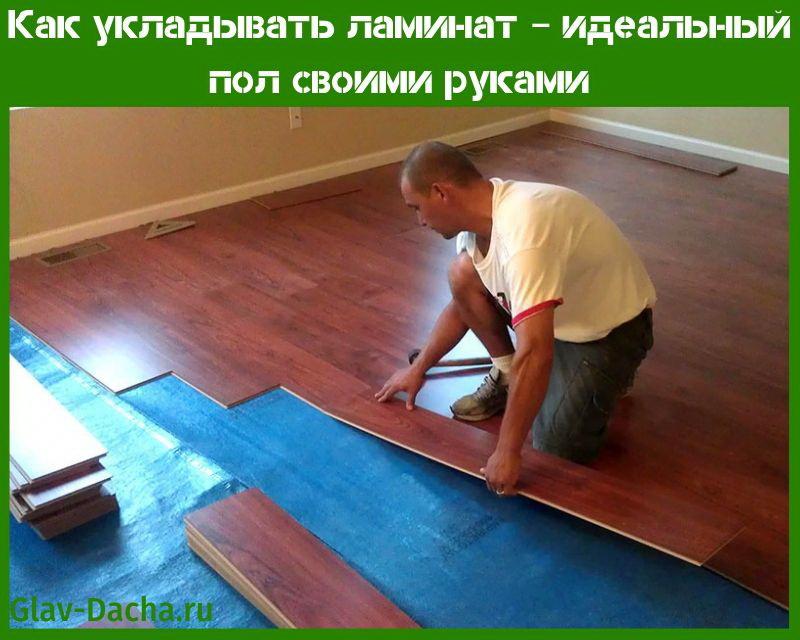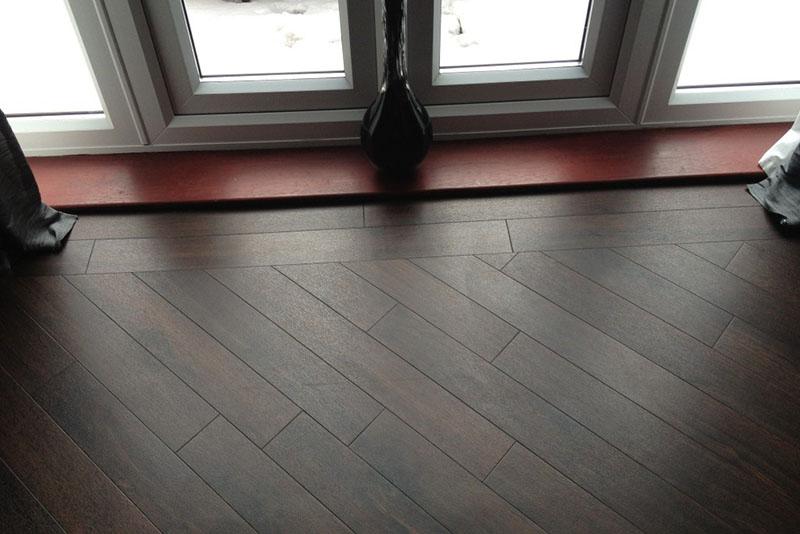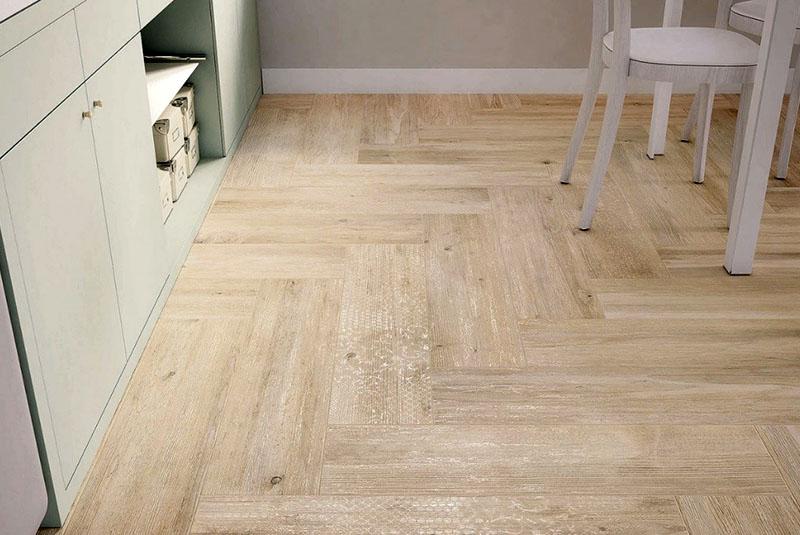How to install laminate flooring - the perfect DIY floor
 Excellent performance properties, practicality, aesthetics and low cost make the laminate one of the most popular and frequently used coatings. However, it is not enough just to choose a high quality product, you still need to know how to lay the laminate, so as not to spoil, but, on the contrary, enhance its high performance.
Excellent performance properties, practicality, aesthetics and low cost make the laminate one of the most popular and frequently used coatings. However, it is not enough just to choose a high quality product, you still need to know how to lay the laminate, so as not to spoil, but, on the contrary, enhance its high performance.
Laminate - a beautiful floor with your own hands

Unlike other materials, laminate flooring is practically non-corrosive. It can be used in any premises. It has not only excellent performance characteristics, but also high decorative qualities. It is capable of imitating any patterns and structures, which makes it indispensable for even the most original and unusual decor.
Laying methods for laminate
There are 4 main ways of laying laminate flooring:
- Herringbone. One of the most difficult, but very effective types of styling. It will require not only professional knowledge, but also the acquisition of special narrow-band material.

- Straight. The simplest and most economical method in which the strips are attached to each other parallel to the wall. Provides excellent visual effect - the surface looks almost monolithic. No more than 7% of the material is used for trimming.

- Thresholdless. Great for combining space, but difficult to install. Requires careful manual fitting of each die and precise adherence to direction.

- Diagonal. Quite a complicated and not economical method of installation. Increases material consumption by 20-30%. Laying the laminate diagonally at an angle of 450... The main advantage of this method is its presentability. Diagonal laying of the laminate allows you to visually increase the space, make it more extensive and voluminous.

You should not deviate from the norms and invent your own ways of laying laminate. Only the right technology will enhance the wear-resistant qualities of the flooring and minimize the weaknesses of the material.
Laminate laying technology
The laminate laying technology includes several stages.
Preparatory
 Before proceeding with the direct assembly of the floor covering, it is necessary to thoroughly clean the room from dirt and dust. Check the surface for unevenness and unevenness and, if necessary, level the floor. Make waterproofing and cover the substrate.
Before proceeding with the direct assembly of the floor covering, it is necessary to thoroughly clean the room from dirt and dust. Check the surface for unevenness and unevenness and, if necessary, level the floor. Make waterproofing and cover the substrate.
The presence of an uneven surface under the laminate can lead to divergence of the locks, the ingress of dirt and dust into the joints, squeaking of the coating, the formation of subsidence of the dies and a decrease in the life of the laminate.
Main
 It is he who includes the direct work on laying the dies. Initially, special wedges are installed around the perimeter of the room, which will serve as a stop for the boards and create an expansion gap near the walls.
It is he who includes the direct work on laying the dies. Initially, special wedges are installed around the perimeter of the room, which will serve as a stop for the boards and create an expansion gap near the walls.
 After the base with the backing and wedges is ready, they begin to lay the first die. You can start work from either side, while making installation, it is necessary to take into account the direction of the rays of light. The direction of the panels should correspond to the direction of light, thus minimizing the degree of visibility of the joints. Provide visual uniformity to the coating.
After the base with the backing and wedges is ready, they begin to lay the first die. You can start work from either side, while making installation, it is necessary to take into account the direction of the rays of light. The direction of the panels should correspond to the direction of light, thus minimizing the degree of visibility of the joints. Provide visual uniformity to the coating.
When laying the first row on the laminate strips, the protruding groove is removed from the side that is adjacent to the wall. All elements are sequentially joined to each other. It is important to avoid distortions. The dies should fit perfectly with each other, not distort either in width or in the direction of the web.
Laying the second row begins with a shortened board, for this, markings are made and the excess part of the die is removed. If the first row starts with a whole strip, then the next one from half or 1/3. Thus, all the rows are collected.
Post-finishing
 After laying the laminate, it is necessary to remove the spacer wedges, install the plinth, and also close the joints between the laminate and other coatings with special decorative overlays.
After laying the laminate, it is necessary to remove the spacer wedges, install the plinth, and also close the joints between the laminate and other coatings with special decorative overlays.
Laminate laying tool

To quickly and correctly lay the laminate, you will need the following tools:
- hammer
- building level
- construction tape
- building corner
- electric jigsaw or fine-toothed hacksaw
- pencil
- electric drill with a feather drill - for forming grooves for pipes
Modern technologies for the production of laminate allow easy assembly and do not require special tools and equipment
Laying methods for laminate
 The laminate assembly technology depends on the type of lock that has the floor covering. By the principle of pairing the dies with each other, I distinguish between two types of systems "Loсk" and "Cliсk"
The laminate assembly technology depends on the type of lock that has the floor covering. By the principle of pairing the dies with each other, I distinguish between two types of systems "Loсk" and "Cliсk"
How to lay laminate with Cliсk system locks
 A feature of this type of lock is that it does not require the use of a hammer. The parts are joined at a certain angle, which is indicated directly by the material manufacturer.
A feature of this type of lock is that it does not require the use of a hammer. The parts are joined at a certain angle, which is indicated directly by the material manufacturer.
The essence of the assembly consists in the introduction, under the required level of inclination, of the spike into the groove of the already laid die. Then the board is laid on the floor and the lock grooves snap together, providing a reliable connection between the dies.
The advantage of this type of laminate is that the dies do not need to be adjusted. Almost invisible, but very reliable joints are formed between them.
Laying laminate with locks type "Loсk"
 Although this type of attachment is losing popularity, it is still encountered quite often. Such a system for fastening laminate dies is more laborious. The grooves and spikes of the joints on the boards are located in the same plane and in order to fasten the laminate strips, it is necessary to correctly insert the spike into the groove and, by tapping, ensure the complete connection of the parts.
Although this type of attachment is losing popularity, it is still encountered quite often. Such a system for fastening laminate dies is more laborious. The grooves and spikes of the joints on the boards are located in the same plane and in order to fasten the laminate strips, it is necessary to correctly insert the spike into the groove and, by tapping, ensure the complete connection of the parts.
It should be noted that when laying 2 and the following strips, it will be necessary to apply forces from both sides - to connect the dies in width and length.
When performing the assembly, it will be necessary to control not only the reliability of the joint, but also the force of the impact. Excessive force may damage the surface of the tongue or groove at the joints.
Laminate laying rules
Like any construction process, laminate flooring requires compliance with certain rules and regulations.
How to lay laminate flooring correctly:
- It is recommended to lay the laminate perpendicular to the substrate. This will avoid the joint between the laminate dies and the base.
- The flooring is not made close to the walls. It is imperative to leave gaps that will allow the laminate to "play" in the off-season and prevent deformation of the seams.
- For rooms with a high level of humidity, laying laminate (except for special types) is not recommended
Laying laminate flooring is a simple and inexpensive solution to make your indoor floor look beautiful and durable. Compliance with the technology of arranging this type of flooring is guaranteed to ensure its durability.